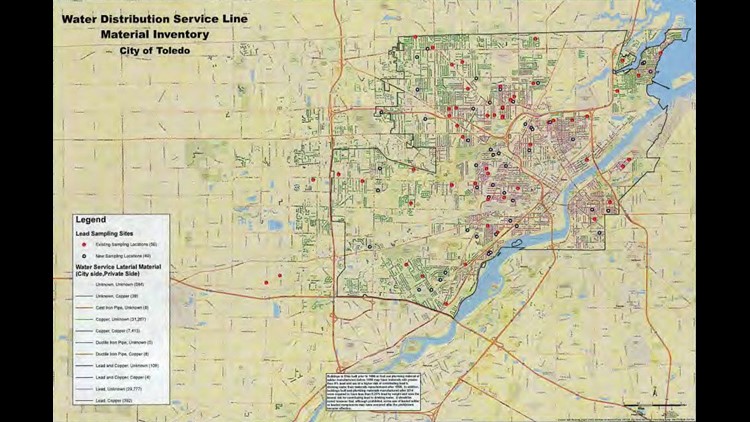TOLEDO, OH (WTOL) - The city of Toledo has released its map of residential lead water lines in the city, and it shows that about 30,000 lines are made of lead.
That's about 40 percent of the water lines.
Many of them are located in the older parts of the city when lead was commonly used in the 19th and 20th centuries.
Toledo and other water agencies throughout the state were under an EPA-mandated deadline to release the information by March 10 of this year. Monday, Ohio EPA spokesperson Heidi Griesmer said 10 water systems still had not submitted maps.
The urgency to create the maps was prompted in large part by the situation in Flint, MI where a new water system allowed the lead in the water lines to leach into the water supply creating a hazardous situation and a shut down of the city's water supply.
"Our program works, and one of the big things in Flint is there was a change, a very significant change in their treatment process. We haven't had a significant change in our treatment process in a long time," said Andy McClure, Collin's Park Water Treatment plant administrator.
McClure says chemicals coat the lining of the lead pipes so lead doesn't come into contact with your water, and the water in the pipes is tested daily to make sure there isn't any corrosion.
Every three years, the city does a lead test on the water from the faucets at certain homes in Toledo.
This year, the city is doubling the number of homes where they test for lead - going from 50 to at least 100.
"All the previous years we've had very low incidents of lead and that's what we anticipate," said McClure.
Last time the test was done in 2014, one of the 50 homes tested showed lead, but it was well below the unacceptable level.
According to the water quality report, a home tested at five parts-per-billion, with the maximum contaminant level at 15 parts-per-billion. The reports say to think of parts-per-billion like this: "One ppb is like one teaspoon of salt in an Olympic-sized pool."
This year, Mcclure says the city has to report any lead findings to the homeowner in two days.
City leaders say the pipes leading into your house and all the plumbing in your house is your responsibility.
"If anyone's really concerned about lead and the plumbing in their house, just first thing in the morning, run the water until you feel a change in temperature, then, then you know you you've got water that hasn't been sitting in the plumbing in your house."
Toledo and nine communities get water from the city's Collin's Park Water Treatment Plant.
The EPA has mandated $500 million of improvements to the plant, but McClure says that doesn't include money to get rid of the lead pipes.
He says a plan is being talked about, but it's too fresh to talk specifics.
They also have problems to work out.
"The lead pipe can be in two parts: It's on the city side and the homeowners' side," said McClure. "So it's very complicated. We have to figure out a way to address both the city side and the homeowner side."





